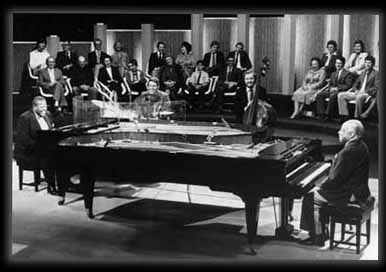     
|
|

|
Oscar Peterson's BBC TV special. From right; Count Basie, Niels-Henning Ørsted Pedersen (bass), Martin Drew (drums) and Oscar Peterson. © BBC Picture Archives
|
William "Count" Basie was born in Red Bank, New Jersey on August 21, 1904. His early musical education was with his mother. He headed to New York as a young man and there he met James P. Johnson, Fats Waller, and other pianists of the Harlem "stride" school. While still in his teens, he toured extensively on the Keith and TOBA vaudeville circuits as a solo pianist, accompanist, and music director.
In the early 1930s, Basie organized his own band and, by 1936, was offered contracts with a national booking company and the Decca Record Company. The following year, Basie expanded his band to the Count Basie Orchestra, and like all bands of the Kansas City tradition, Basie's was organized around its rhythm section, which used an elliptical style of melodic leads and cues. From his keyboard, Basie was able to control the group while blending perfectly with his rhythm section. Basie's Orchestra soon became one of the leading big bands of the swing era. By the end of the 1930s, the band had acquired international fame with such pieces as Jumpin' at the Woodside (1938) and Taxi War Dance (1939).
Basie appeared in many films in the 1940s, and after a reorganization of the band in 1952, began extensive touring through Europe and the production of many recordings. The highlight of these tours came in 1957 when Basie's orchestra played a command performance at Buckingham Palace for Queen Elizabeth II. With such an impressive history, Count Basie was increasingly viewed as an elder statesman of jazz, and his band established itself as a permanent jazz institution and training ground for young musicians. 1
Throughout the 1960s, he issued many recordings both under his name and in partnership with various singers, most notably Frank Sinatra. The band also made several appearances on television and in the films Cinderfella (1960) and Sex And The Single Girl (1964) during this decade.
Basie's association with Oscar Peterson began with the JATP (Jazz at the Philharmonic) with which they toured together through North America and Europe in the 1940s and 50s. Basie also performed on 10 Oscar Peterson albums in the 1970s, and even made an appearance on Peterson's BBC talk show in 1976 despite his deteriorating health. By the 1980s, Basie was devoting his time to writing his autobiography rather than performing. Even after Basie's death in April 1984, the band continued under the direction of Thad Jones (1985-86) and Frank Foster (from 1986). A number of his former sidemen occasionally reconvened for concerts and tours as the Countsmen. The Count Basie Orchestra has proven to be the most long-lived and enduring band in jazz history.
Selected recordings:
Swinging at the Daisy Chain (1937, Decca 1121)
Good Morning Blues (1937, Decca 1446)
Satch and Josh... Again, with Oscar Peterson (1977, Pablo 8738)
Yessir That's My Baby, with Oscar Peterson (1978, Pablo 2310-932-2)
Footnotes
1 Kernfeld, Barry. The New Grove Dictionary of Jazz. London: Macmillan Press Ltd, 1988.
O.P. & Friends
Previous | Next
|
